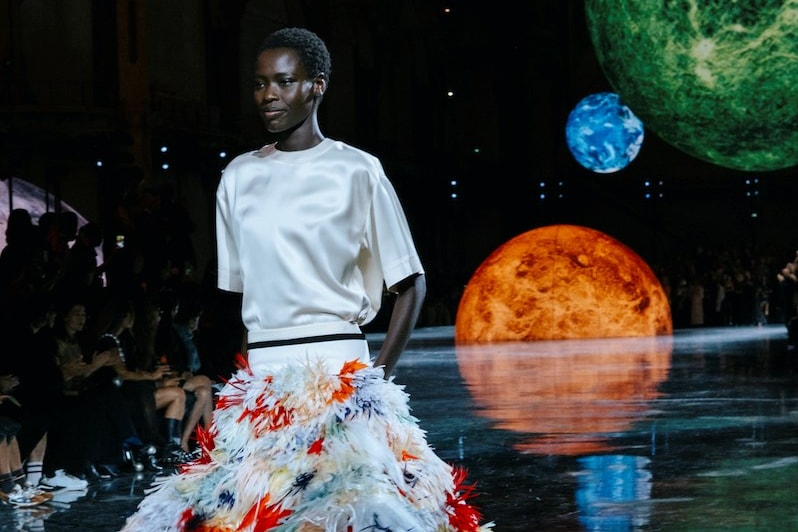
Rewrite
Lead ImageChanel Spring/Summer 2026 Photography by Christina Fragkou
What makes a great fashion show? How about a proposition of an aesthetic that feels bold and brave? How about a weight of anticipation unequivocally delivered upon? Within a heritage fashion house – a phrase I loathe, but how else to describe these entrenched, decades-old Parisian Maisons being ripped apart and remade in a modern image – how about an inherent knowledge of but healthy disrespect for the past? And, actually, what about just some fantastic, inspiring, plainly and simply beautiful clothes. As a white slithery satin charmeuse dress, knotted casually at hip and shoulder, swept through the vast darkened nave of the Grand Palais, it was obvious that whatever defines greatness was vibrantly, triumphantly present at Matthieu Blazy’s outstanding debut show for the house of Chanel. It took your breath away.
That is no mean feat. Chanel’s legacy is incredible but weighty, a load only added to by the heft of the talent of Karl Lagerfeld, who reinvented Chanel in the 1980s and powered it across four decades. Gabrielle Chanel changed how people dress – she was the only fashion designer included in Time magazine’s list of the most influential people of the 20th century, and she deserved her place. Karl Lagerfeld transformed how fashion itself operates – he invented our current formula for the reinvention of a fashion name of the past, a blueprint for brand resuscitation we have seen much-played out with many varying degrees of success over the past month. So it would have been entirely understandable for Blazy to buckle under the pressure. Or, perhaps to rest on his laurels. Chanel is a brand of multiple billions, with the only style of clothing that deserves the overused, near-meaningless epithet of ‘iconic’. It’s easy street.
Nothing about what Matthieu Blazy did for Chanel was easy, except the way it looked, and probably the way it will feel. He chopped his Chanel debut into distinct sections. “Three chapters,” was how Blazy described it backstage. One was dedicated to Chanel’s global appeal (Universal), the other to the house’s daywear (Le Jour), and the first the notion of Chanel’s ‘paradox’, her borrowing from the wardrobe of a man, “so she became the equal of him,” Blazy said, yet contrasting with a seductive vision in the evening. The opening jacket was based on Blazy’s own, taken off his back when he began at Chanel and sliced raw, to a Chanel proportion. It was a Chanel suit, but not a ‘Chanel Suit’ – a knowing, bold and provocative opening declaration, when everyone was expecting what we know they were expecting. The gilt buttons were logo-less – they were the same kind of knobbly, baroque buttons Chanel used in the 1960s. And peeking above the waistband were a pair of thick ribbed ivory underwear. They were jersey, the fabric Chanel herself stole from men’s underwear to reshape women’s wardrobe. They also nodded to a Karl Lagerfeld collection, when he upended Chanel’s legacy and proposed branded Y-fronts as outerwear for women. And, apparently, Blazy’s grandfather worked in an underwear factory. The three ages of Chanel, in a single pair of kecks.
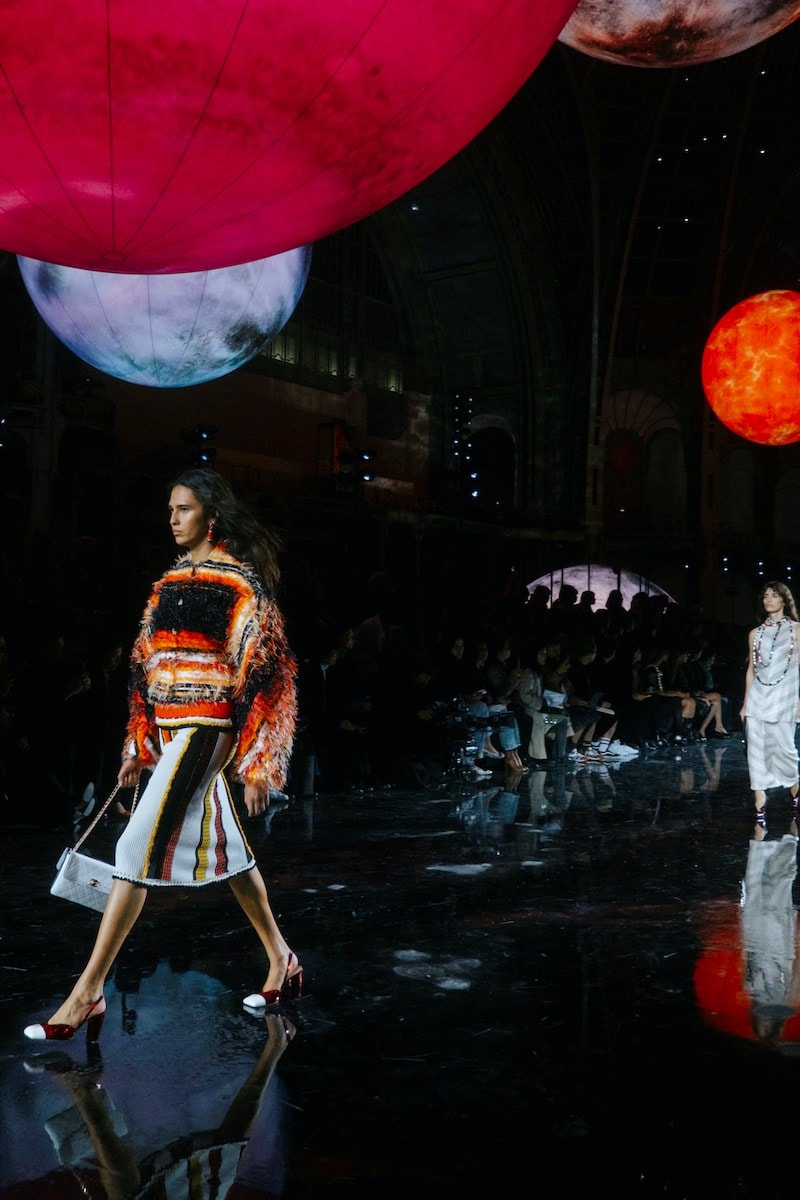
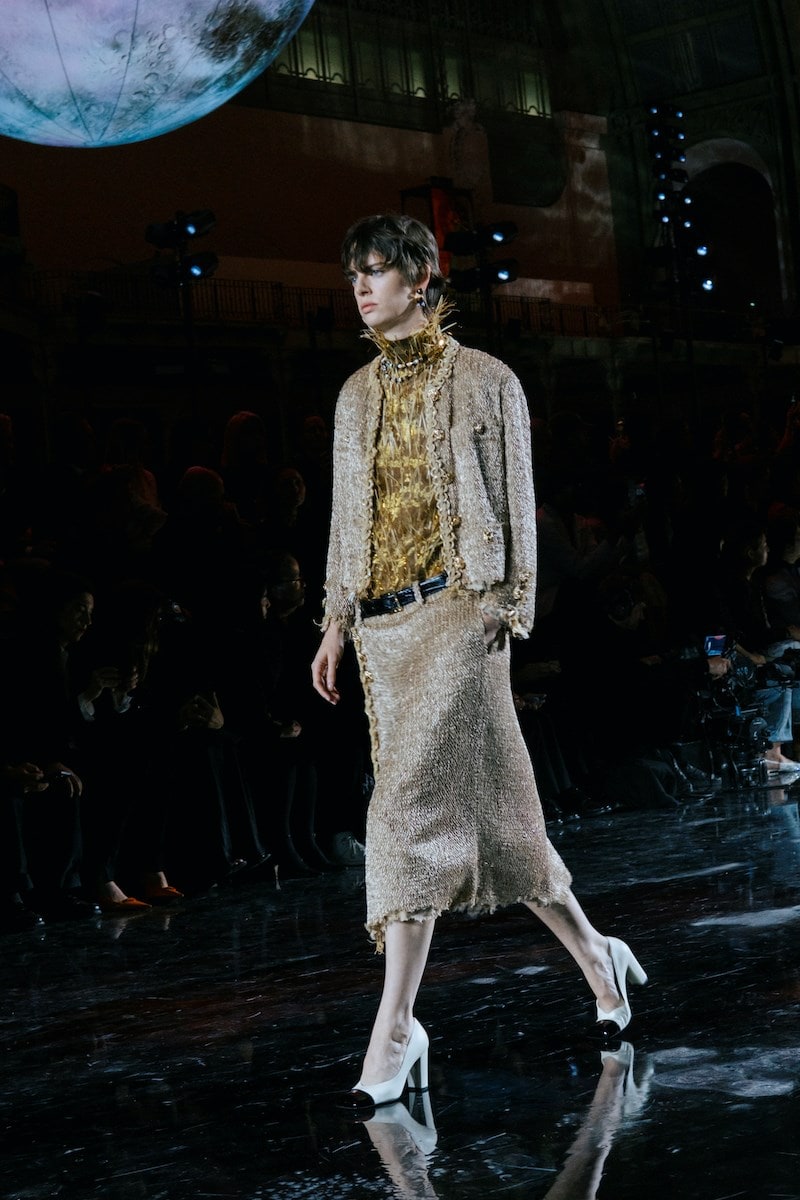
That’s the thing with Chanel – you can trace almost anything to the identity of the house, given the richness of its history. The most striking example in this show, in a sequence of very many examples, was a series of extravagant evening skirts, ruffled or embroidered, worn with men’s shirts created with Charvet, the Parisian gentlemen’s outfitter. Chanel was a client – here, they were credited with ‘tissu et technique’ on a co-branded label, the cursive of Chanel borrowed from her earliest house label from the 1910s, also used as a monogram. The shirts sported pearl cufflinks, hemmed with the chains Chanel sewed into her fluid jackets (serving the same function here, to weight the garment to the body) and were executed in fine cotton – Chanel once said her favourite fabric was cotton because it took dye best. Although she also said she loved cheap cotton, which these shirts certainly weren’t.
That’s an exemplar of the depth of knowledge and clarity of intent in what Blazy did. It felt like it was there in every piece, a firmly seated knowledge of an ideology of Chanel, rather than a tinkering with its surface. Chanel, of late, has become by rote – identifiable signifiers shifting, without carrying any meaning. This show was a true reflection not just of the lazy notion of ‘house codes’ but of purpose. “You can look at the codes, and make them very clean – or you can look at them from another perspective,” Blazy commented.
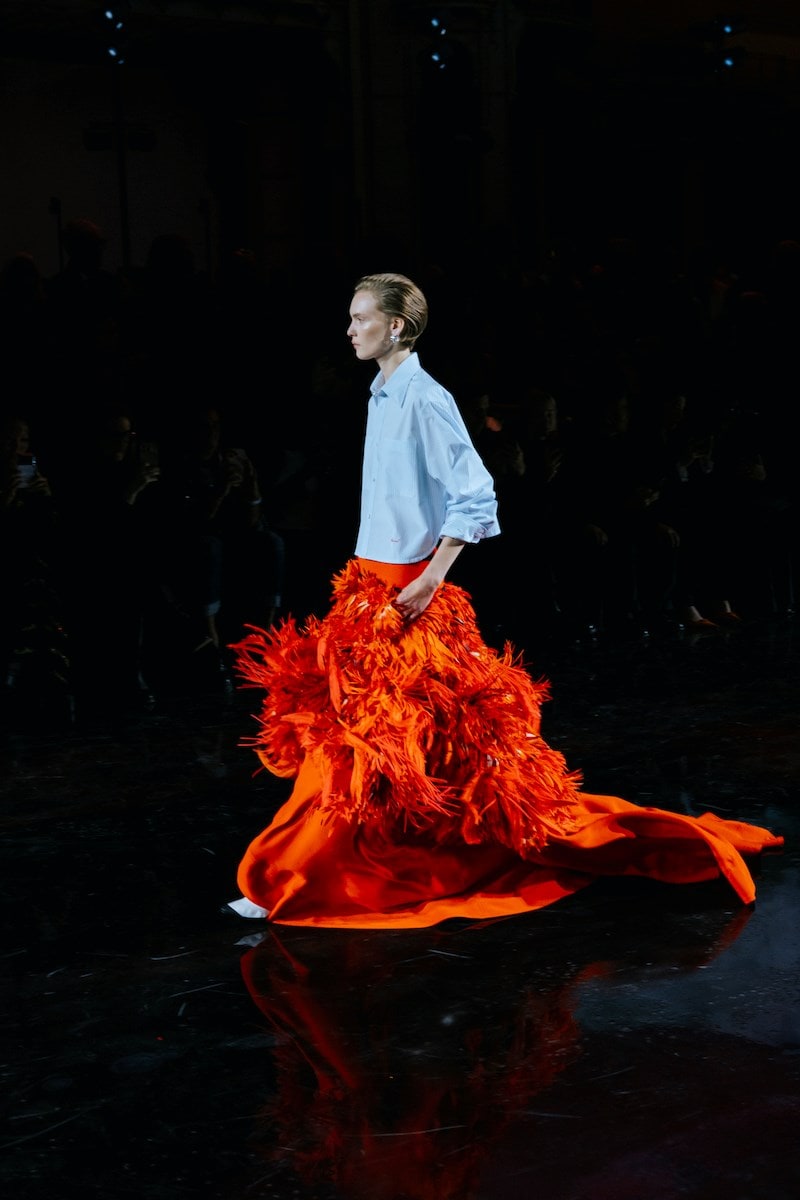
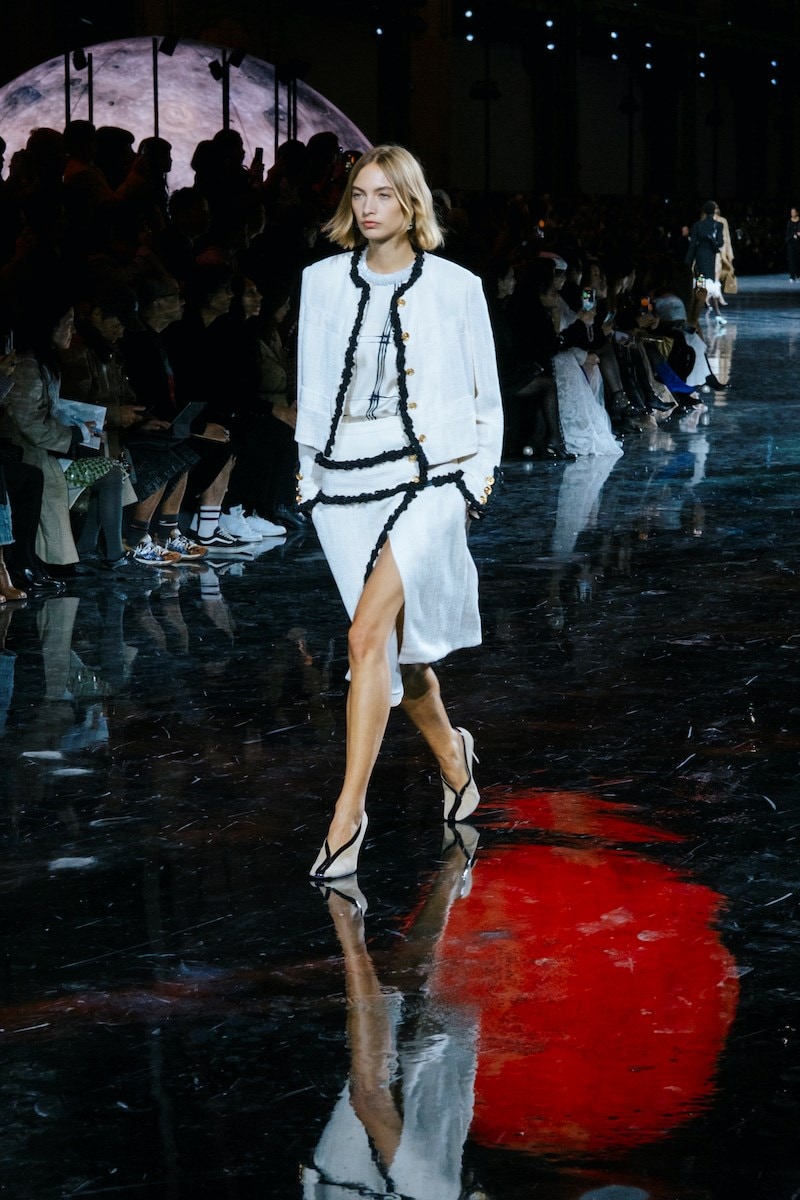
And they were all there, whizzed through, again and again, a cavalcade of brilliance – I can’t think of another word. Tweed suits with low-slung wrapped skirts, dresses waltzing around the body with embroidered flowers, like Chanel prints from the 1920s leaping into three dimensions. Blasts of Chanel red – as much a signature colour as black, or white, or the beige that Chanel loved because it looked like dirt, which were all present, of course. And less famous histories, too, like those ruffled skirts echoing ‘gypsy’ styles Chanel introduced in the 1930s. The 2.55 was twisted, intentionally malformed, as if it had lived a life – it’s 70 years old this year, so it has. “It’s like it’s been borrowed from your great-grandmother and passed through generations,” said Blazy. Which, of course, it has been.
Universal was a word Blazy used – and Chanel has a universality, a universal appeal. Everyone thinks they know what Chanel was, is, should be. And maybe they do. But shouldn’t it be a designer’s job to challenge those presumptions, to show us something different, to confound, maybe even confuse, eventually to seduce, like Gabrielle Chanel herself did so very well? Blazy told a story backstage about Chanel dressing in drag as a man in the 1910s. Her friends laughed, uproariously. A few days later, Chanel wore the look again – because she had decided it wasn’t a costume, to play, but rather a shift in aesthetic, in identity. It predicted the 20th century.
Blazy’s work doesn’t predict the 21st. Fashion doesn’t hold that kind of power anymore – no single designer can change the way the world looks and thinks the way Chanel did. But what a great designer can do, perhaps, is change the way the world feels. The very final skirt in the very final look of this very first show, tufted with extraordinary organza flowers and feather by Chanel-owned master atelier Lemarié, referenced the luminescent floral bouquets you see glowing in 17th-century Flemish painting. It’s a serious reference, a heavy history, a lot of work. Ring any bells? But Blazy said his team call it “piña colada” and the final model, Awar Odhiang, danced joyously in it under the stars as the audience leapt and applauded. Isn’t that what you want fashion to do? Isn’t that how you want fashion to make you feel?
in HTML format, including tags, to make it appealing and easy to read for Japanese-speaking readers aged 20 to 40 interested in fashion. Organize the content with appropriate headings and subheadings (h1, h2, h3, h4, h5, h6), translating all text, including headings, into Japanese. Retain any existing
tags from
Lead ImageChanel Spring/Summer 2026 Photography by Christina Fragkou
What makes a great fashion show? How about a proposition of an aesthetic that feels bold and brave? How about a weight of anticipation unequivocally delivered upon? Within a heritage fashion house – a phrase I loathe, but how else to describe these entrenched, decades-old Parisian Maisons being ripped apart and remade in a modern image – how about an inherent knowledge of but healthy disrespect for the past? And, actually, what about just some fantastic, inspiring, plainly and simply beautiful clothes. As a white slithery satin charmeuse dress, knotted casually at hip and shoulder, swept through the vast darkened nave of the Grand Palais, it was obvious that whatever defines greatness was vibrantly, triumphantly present at Matthieu Blazy’s outstanding debut show for the house of Chanel. It took your breath away.
That is no mean feat. Chanel’s legacy is incredible but weighty, a load only added to by the heft of the talent of Karl Lagerfeld, who reinvented Chanel in the 1980s and powered it across four decades. Gabrielle Chanel changed how people dress – she was the only fashion designer included in Time magazine’s list of the most influential people of the 20th century, and she deserved her place. Karl Lagerfeld transformed how fashion itself operates – he invented our current formula for the reinvention of a fashion name of the past, a blueprint for brand resuscitation we have seen much-played out with many varying degrees of success over the past month. So it would have been entirely understandable for Blazy to buckle under the pressure. Or, perhaps to rest on his laurels. Chanel is a brand of multiple billions, with the only style of clothing that deserves the overused, near-meaningless epithet of ‘iconic’. It’s easy street.
Nothing about what Matthieu Blazy did for Chanel was easy, except the way it looked, and probably the way it will feel. He chopped his Chanel debut into distinct sections. “Three chapters,” was how Blazy described it backstage. One was dedicated to Chanel’s global appeal (Universal), the other to the house’s daywear (Le Jour), and the first the notion of Chanel’s ‘paradox’, her borrowing from the wardrobe of a man, “so she became the equal of him,” Blazy said, yet contrasting with a seductive vision in the evening. The opening jacket was based on Blazy’s own, taken off his back when he began at Chanel and sliced raw, to a Chanel proportion. It was a Chanel suit, but not a ‘Chanel Suit’ – a knowing, bold and provocative opening declaration, when everyone was expecting what we know they were expecting. The gilt buttons were logo-less – they were the same kind of knobbly, baroque buttons Chanel used in the 1960s. And peeking above the waistband were a pair of thick ribbed ivory underwear. They were jersey, the fabric Chanel herself stole from men’s underwear to reshape women’s wardrobe. They also nodded to a Karl Lagerfeld collection, when he upended Chanel’s legacy and proposed branded Y-fronts as outerwear for women. And, apparently, Blazy’s grandfather worked in an underwear factory. The three ages of Chanel, in a single pair of kecks.


That’s the thing with Chanel – you can trace almost anything to the identity of the house, given the richness of its history. The most striking example in this show, in a sequence of very many examples, was a series of extravagant evening skirts, ruffled or embroidered, worn with men’s shirts created with Charvet, the Parisian gentlemen’s outfitter. Chanel was a client – here, they were credited with ‘tissu et technique’ on a co-branded label, the cursive of Chanel borrowed from her earliest house label from the 1910s, also used as a monogram. The shirts sported pearl cufflinks, hemmed with the chains Chanel sewed into her fluid jackets (serving the same function here, to weight the garment to the body) and were executed in fine cotton – Chanel once said her favourite fabric was cotton because it took dye best. Although she also said she loved cheap cotton, which these shirts certainly weren’t.
That’s an exemplar of the depth of knowledge and clarity of intent in what Blazy did. It felt like it was there in every piece, a firmly seated knowledge of an ideology of Chanel, rather than a tinkering with its surface. Chanel, of late, has become by rote – identifiable signifiers shifting, without carrying any meaning. This show was a true reflection not just of the lazy notion of ‘house codes’ but of purpose. “You can look at the codes, and make them very clean – or you can look at them from another perspective,” Blazy commented.


And they were all there, whizzed through, again and again, a cavalcade of brilliance – I can’t think of another word. Tweed suits with low-slung wrapped skirts, dresses waltzing around the body with embroidered flowers, like Chanel prints from the 1920s leaping into three dimensions. Blasts of Chanel red – as much a signature colour as black, or white, or the beige that Chanel loved because it looked like dirt, which were all present, of course. And less famous histories, too, like those ruffled skirts echoing ‘gypsy’ styles Chanel introduced in the 1930s. The 2.55 was twisted, intentionally malformed, as if it had lived a life – it’s 70 years old this year, so it has. “It’s like it’s been borrowed from your great-grandmother and passed through generations,” said Blazy. Which, of course, it has been.
Universal was a word Blazy used – and Chanel has a universality, a universal appeal. Everyone thinks they know what Chanel was, is, should be. And maybe they do. But shouldn’t it be a designer’s job to challenge those presumptions, to show us something different, to confound, maybe even confuse, eventually to seduce, like Gabrielle Chanel herself did so very well? Blazy told a story backstage about Chanel dressing in drag as a man in the 1910s. Her friends laughed, uproariously. A few days later, Chanel wore the look again – because she had decided it wasn’t a costume, to play, but rather a shift in aesthetic, in identity. It predicted the 20th century.
Blazy’s work doesn’t predict the 21st. Fashion doesn’t hold that kind of power anymore – no single designer can change the way the world looks and thinks the way Chanel did. But what a great designer can do, perhaps, is change the way the world feels. The very final skirt in the very final look of this very first show, tufted with extraordinary organza flowers and feather by Chanel-owned master atelier Lemarié, referenced the luminescent floral bouquets you see glowing in 17th-century Flemish painting. It’s a serious reference, a heavy history, a lot of work. Ring any bells? But Blazy said his team call it “piña colada” and the final model, Awar Odhiang, danced joyously in it under the stars as the audience leapt and applauded. Isn’t that what you want fashion to do? Isn’t that how you want fashion to make you feel?
and integrate them seamlessly into the new content without adding new tags. Ensure the new content is fashion-related, written entirely in Japanese, and approximately 1500 words. Conclude with a “結論” section and a well-formatted “よくある質問” section. Avoid including an introduction or a note explaining the process.


